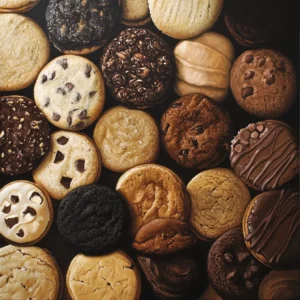Choosing the best oats for cookies is essential for achieving the perfect bake. Both quick oats and old-fashioned oats offer unique benefits, but selecting the right one can make a noticeable difference in flavor and texture. So, what makes the best oats for cookies? In this guide, we’ll explore their differences and help you decide which oats truly deserve the title of the best oats for cookies for your recipe.
This comprehensive guide will compare quick oats and old-fashioned oats, exploring their impact on cookies’ texture, flavor, and nutritional value. By the end, you’ll know which oat type suits your specific baking needs.
Understanding Quick Oats and Old-Fashioned Oats
What Are Quick Oats?
Quick oats, often referred to as instant oats, are pre-processed oats that are designed for faster cooking. They are thinner and more refined than old-fashioned rolled oats, as they are steamed and flattened more extensively during processing.
This makes quick oats an appealing choice for quick recipes like instant oatmeal or no-cook dishes, where preparation time is limited. However, their finer texture and reduced structure may not provide the same hearty flavor and chewiness as old-fashioned oats, particularly in baking applications like cookies or granola bars. Quick oats are best suited for recipes where a softer, more uniform texture is desired.
How Quick Oats Are Made
Quick oats undergo an extensive processing method designed to significantly reduce cooking time. The process begins with oat groats, which are steamed to soften them. They are then rolled thinner and, in some cases, cut into smaller pieces. This pre-cooking process ensures that quick oats cook rapidly, making them a convenient option for busy individuals or those looking for a fast, nutritious meal.
While their processing makes them ideal for quick breakfasts or snacks, the texture and flavor of quick oats are less robust compared to old-fashioned rolled oats, limiting their versatility in certain recipes like cookies or granola bars. However, they remain a popular choice for their speed and ease of use.
Nutritional Profile of Quick Oats
Quick oats retain most of the nutrients found in whole oats, including fiber, protein, and essential vitamins like B1 (thiamine). However, the increased processing may slightly reduce their nutritional density compared to old-fashioned oats.
What Are Old-Fashioned Oats?
Old-fashioned oats, also known as rolled oats, are minimally processed compared to quick oats. They are made by steaming oat groats and rolling them into flat flakes, preserving much of their structure and texture. This minimal processing gives old-fashioned oats their distinct chewy, hearty bite, making them a versatile choice for a variety of recipes.
Because they maintain their integrity, old-fashioned oats are ideal for baking, cooking, and making granola. They hold up well during preparation, adding texture and flavor to dishes, whether it’s oatmeal, cookies, or savory recipes like meatloaf. Their robust texture and nutty flavor make them a staple ingredient for those seeking wholesome, satisfying meals.
Production Process of Old-Fashioned Oats
The production process of old-fashioned oats involves steaming whole oat groats to soften them and then rolling them into flat flakes. This minimal processing helps preserve their natural texture, flavor, and nutritional content.
By retaining much of their original structure, old-fashioned oats offer a hearty, chewy consistency that works well in a wide variety of recipes, from oatmeal and cookies to granola and savory dishes. Their less-refined nature makes them a popular choice for those seeking wholesome, nutrient-rich ingredients.
Nutritional Profile of Old-Fashioned Oats
Old-fashioned oats are a powerhouse of nutrition, offering several health benefits. They are particularly high in soluble fiber, which has been shown to support heart health by helping to lower cholesterol levels. This makes them an excellent choice for maintaining cardiovascular wellness.
In addition to fiber, old-fashioned oats are rich in protein, providing a plant-based source of this essential nutrient. They also contain significant amounts of iron and magnesium, which play key roles in energy production and maintaining strong bones.
Whether used in oatmeal, baked goods, or savory recipes, old-fashioned oats are a versatile and nutritious addition to any diet. Their combination of fiber, protein, and minerals makes them a staple for promoting overall health and well-being.
The Science Behind Cookies: How Ingredients Impact Texture and Flavor
The Role of Oats in Cookies
Oats play a crucial role in enhancing cookies, contributing to both their flavor and texture. The natural nutty undertone of oats adds depth, complementing the sweetness of other ingredients like sugar and chocolate.
In addition to flavor, oats improve the texture of cookies by acting as a binding agent. They help create a chewy, soft consistency, making cookies more satisfying and hearty. The nutritional benefits of oats also boost the overall value of cookies, adding fiber, protein, and essential minerals. This combination of taste, texture, and nutrition makes oats an excellent ingredient in a wide range of cookie recipes.
Differences in Cookie Texture Using Quick vs. Old-Fashioned Oats
Crispness and Chewiness
- Quick Oats: These oats blend seamlessly into cookie dough, resulting in softer cookies with a uniform texture. Their finer consistency reduces chewiness but increases smoothness.
- Old-Fashioned Oats: Cookies made with old-fashioned oats have a chunkier texture. These oats retain their shape, creating a hearty and chewy bite.
Absorption and Baking Time
- Quick Oats: Absorb liquids faster, reducing baking time. This can make cookies moist but less structured.
- Old-Fashioned Oats: Absorb liquids slower, often requiring a slightly longer baking time. They hold their shape better, giving cookies a robust texture.
Flavor and Texture Comparison
How Quick Oats Affect Flavor
Quick oats have a milder flavor compared to rolled oats due to their smaller size and increased processing. This more refined texture allows them to blend seamlessly into recipes without overpowering other ingredients. Their subtle flavor makes them particularly well-suited for delicate recipes, such as those featuring vanilla, peanut butter, or light fruit flavors. Quick oats provide a smooth, consistent texture while maintaining the benefits of oats without dominating the taste of the dish. This makes them a versatile option in many baked goods and snack recipes.
How Old-Fashioned Oats Affect Flavor
Old-fashioned oats bring a stronger, nuttier taste to cookies, enhancing their flavor profile with a hearty and satisfying texture. This makes them an excellent choice for recipes that feature bold flavors such as cinnamon, chocolate, or dried fruits. The chewy consistency of old-fashioned oats adds depth and substance to the cookies, creating a more substantial bite. Their robust flavor pairs beautifully with rich ingredients, making them a key ingredient in classic oatmeal cookies and other baked goods.
Nutritional Comparison: Quick Oats vs. Old-Fashioned Oats in Cookies
Fiber Content
Both old-fashioned oats and quick oats are excellent sources of dietary fiber, which plays a crucial role in supporting digestion and maintaining healthy cholesterol levels. The fiber in oats helps promote a feeling of fullness, making them a great addition to a balanced diet.
However, old-fashioned oats may contain slightly more fiber due to their minimal processing. The less refined nature of old-fashioned oats allows them to retain more of their natural fiber, making them a slightly better option for those seeking to increase their fiber intake. Whether you choose old-fashioned or quick oats, both provide valuable health benefits, but old-fashioned oats may offer a bit more nutritional value due to their higher fiber content.
Glycemic Index
Quick oats have a higher glycemic index (GI) compared to old-fashioned oats. The glycemic index measures how quickly a food raises blood sugar levels after consumption. Foods with a higher GI cause a faster spike in blood sugar, which could be a concern for individuals managing diabetes or those who prefer low-GI options to maintain stable blood sugar levels.
Old-fashioned oats, with their lower GI, are digested more slowly, providing a more gradual release of energy and a steadier impact on blood sugar. For those looking to manage blood sugar or follow a low-GI diet, old-fashioned oats are a better choice. However, quick oats still offer nutritional benefits and can be enjoyed in moderation as part of a balanced diet.
Micronutrients and Additives
Old-fashioned oats are generally free from additives, making them a pure, whole-grain option with no added sugars, preservatives, or flavorings. This makes them an excellent choice for those looking for a more natural, minimally processed ingredient.
On the other hand, some quick oats, especially pre-flavored varieties, may contain added sugars, preservatives, or artificial flavorings to enhance taste and extend shelf life. For those seeking a healthier, more wholesome choice, it’s important to read labels carefully and opt for plain, unflavored quick oats to avoid unnecessary additives.
Best Cookie Recipes for Quick Oats
Easy Peanut Butter Oatmeal Cookies
Quick oats are an excellent choice for peanut butter cookies, as they contribute to a soft, melt-in-your-mouth texture. The fine texture of quick oats allows them to blend seamlessly into the dough, creating a chewy consistency that pairs beautifully with the richness of peanut butter.
To make a simple yet delightful treat, mix peanut butter, sugar, eggs, and quick oats. The oats provide a subtle nutty flavor while helping bind the ingredients together, resulting in a delicious, easy-to-make cookie. Whether for a quick snack or a special occasion, these cookies offer a satisfying and flavorful option.
Chocolate Chip Quick Oat Cookies
These cookies combine the smoothness of quick oats with the gooey goodness of chocolate chips, creating a perfect balance of flavor and texture. The finer texture of quick oats ensures the dough is even and consistent, giving each cookie a uniform, satisfying bite. The oats complement the richness of the chocolate chips, making every bite a delicious treat. Whether enjoyed with a glass of milk or as a sweet snack, these cookies are sure to please with their chewy texture and irresistible chocolate flavor.
Best Cookie Recipes for Old-Fashioned Oats
Classic Oatmeal Raisin Cookies
The chewy texture of old-fashioned oats pairs perfectly with the sweetness of raisins and a hint of cinnamon, creating a comforting and flavorful combination. These cookies are a nostalgic favorite for many bakers, evoking memories of traditional baking. The hearty oats provide a satisfying bite, while the raisins add natural sweetness and the cinnamon offers a warm, aromatic touch. Whether enjoyed as a snack or shared with loved ones, these cookies are a timeless treat that brings warmth and comfort to any occasion.
Rustic Cranberry Almond Oat Cookies
Old-fashioned oats provide a hearty base for tangy cranberries and crunchy almonds, making these cookies a delicious and textured treat. The chewy oats complement the tartness of the cranberries, while the almonds add a satisfying crunch. These cookies are ideal for those who enjoy a rustic, flavorful dessert with a mix of textures. The combination of oats, fruit, and nuts creates a balanced, wholesome snack that’s perfect for any occasion, whether as an afternoon treat or a holiday favorite.
Practical Considerations When Choosing Oats
Cooking Time and Convenience
- Quick Oats: Ideal for quick recipes due to their short cooking time.
- Old-Fashioned Oats: Require more preparation but deliver a superior texture.
Availability and Cost
Both oat types are widely available, but pricing may vary based on processing and packaging. Bulk old-fashioned oats are often more cost-effective.
Substitution Tips
Quick oats can substitute old-fashioned oats in most recipes, though the texture may change. For best results, blend old-fashioned oats briefly if using them in place of quick oats.
Frequently Asked Questions About Oats in Cookies
- Can I Substitute Quick Oats for Old-Fashioned Oats in Any Recipe?
Yes, but expect differences in texture and consistency. Quick oats create softer cookies, while old-fashioned oats add chewiness. - Do Quick Oats or Old-Fashioned Oats Offer Better Health Benefits in Cookies?
Old-fashioned oats may retain more fiber and nutrients due to less processing, making them a slightly healthier option. - How Can I Prevent Cookies from Spreading Too Much with Oats?
Chill the dough before baking and use parchment paper to control spreading. - Are Quick Oats Gluten-Free Like Old-Fashioned Oats?
Both types are gluten-free if labeled as such. However, cross-contamination can occur during processing, so check the packaging. - What’s the Best Oat-to-Flour Ratio for Perfect Cookies?
A 1:2 oat-to-flour ratio often works well for balanced texture and structure. - How Should I Store Oatmeal Cookies to Keep Them Fresh?
Store cookies in an airtight container at room temperature. For extended freshness, freeze them in a resealable bag.
Conclusion: Which Oat Type Is Right for Your Cookies?
The choice between quick oats and old-fashioned oats ultimately depends on your preferences and the recipe. Quick oats are perfect for soft, uniform cookies that bake quickly, while old-fashioned oats add chewiness and a hearty texture. For a well-rounded approach, experiment with both types to discover your ideal cookie!
Related article:
Why Can’t You Use Instant Oats in Cookies?



